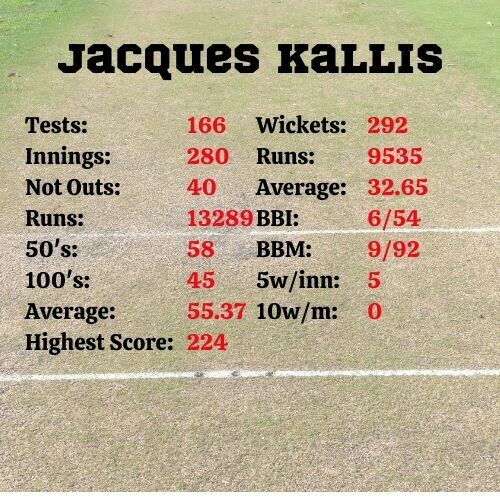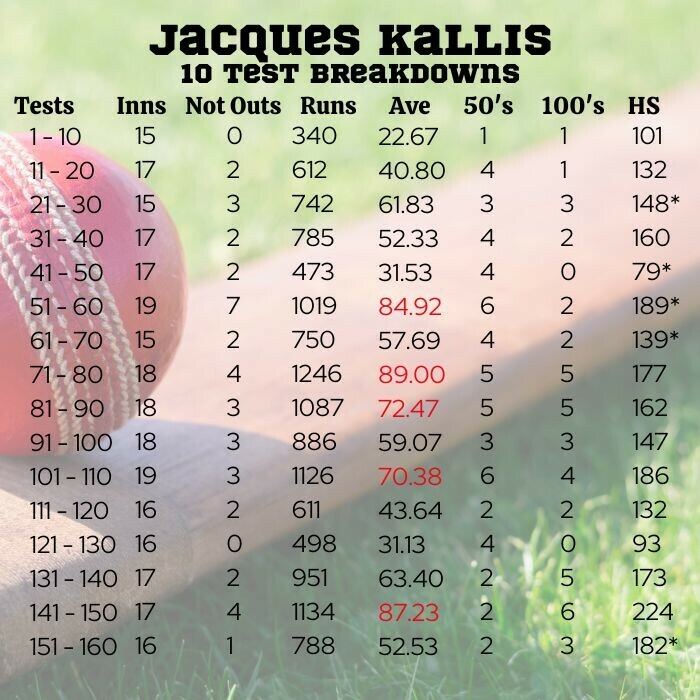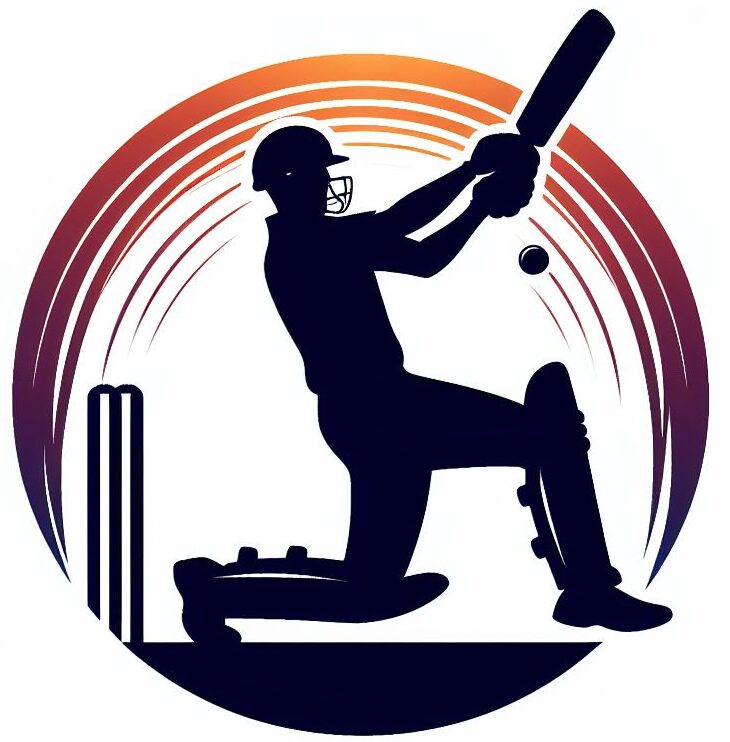Jacques Kallis, born on October 16, 1975, in Cape Town, South Africa, stands as a towering figure in the realm of cricket. His batting alone, scoring 13,289 runs in test cricket with 45 centuries and an average 55.37, as well as 11,579 One Day International runs at an average of 44.36 with 17 centuries would be enough, on their own, for Kallis to be considered one of the great batsman cricket has ever produced.

Jacques Kallis YellowMonkey/Blnguyen, CC BY-SA 4.0, via Wikimedia Commons
The fact that he was also a fast bowler, picking up 292 test wickets at an average of 32.65 and 273 one day wickets at an average of 31.79, puts Kallis in rarefied air indeed. Many people believe he, along with Sir Garfield Sobers, could lay claim as being the greatest allrounders to have ever played the game.
Introduction to Jacques Kallis
Jacques Kallis was born into a sports-loving family. From his childhood days, Kallis showed a natural aptitude for cricket, displaying remarkable hand-eye coordination and a solid technique.
At the age of 13, Kallis was selected to represent Western Province at the Under-15 level, but he was subsequently dropped for, ironically, being too small to hit the ball off the square. This was only a small blip, because his talent and potential became evident to coaches and selectors, and he quickly progressed through the ranks of age-group cricket.
In 1993, at the age of 18, Kallis made his debut for the South African Under-19 team, showcasing his skills on the international stage. His performances caught the attention of talent scouts and cricketing authorities; he played a couple of seasons of cricket in England, and in his second season, for Netherfield, he scored 791 runs at an average of 98.87.
He made his first-class debut for Western Province in the 1993-94 season. His consistent performances earned him a call-up to the South African national team in December 1995 for a test match against England.

In a rain affected match where the final two days were rained out, as was much of Day 3, Kallis batting at 6, managed just 1 off 11 balls. He would not bowl in England’s single and only half-completed innings.
He would miss South Africa’s next test, but return for the following, the fifth of England’s tour. From a personal point of view, it wasn’t much better than his first, but at least South Africa won the test, the only of the 5 tests to finish with a result. He scored 7 in almost 2 hours at the crease, and he also sent down 4 overs for 2 runs and no wickets in England’s first innings.
It was a tough start for the future legend. After 5 tests, he averaged just 8.14 with the bat. His sixth match would bring him his first half-century, a score of 61 off 153 balls against Pakistan, and his seventh match would bring him his first century, a tough and gritty effort score of 101 off 279 balls as South Africa held on for 122 overs to draw the match against Australia.
This took his average above 20 for the first time. At the end of his 20th test, his average passed 30 for the first time. It hit 40 at the end of his 26th test, and 50 at the end of his 63rd test. It would eventually top out at 58.11 at the end of his 114th test.
Jacque Kallis’ Test Career … for the stats nerds.

For these stats, we’ll look mainly at his batting statistics, as that was the skillset that he particularly excelled in.
Jacques Kallis scored 13,289 runs in his batting career, the third most runs in a test career, coming only 89 runs short of Ricky Ponting’s test career runs value. Out of all the batsmen who scored 10,000 runs or more, he is the only one to have taken more than 100 wickets, having taken 292 of them.
In fact, if you add up the number of wickets the other 13 10,000+ run achievers have taken, they reach 277 wickets, still 15 short of Kallis’ total.
He scored 45 test centuries, the second most by any batsman, behind Sachin Tendulkar’s 51, and is equal with Ricky Ponting in second place for the most number of scores equal to or above 50 (103, behind Sachin Tendulkar’s 119).
He has also won 23 player of the match awards in tests, more than any other player.
His best 10 innings stretch depends on what you call ‘best’. His highest average over the course of 10 innings was an incredible 177.75, when he scored 771 runs in 10 innings from April 2001 to December 2001. This was helped by 6 not outs.
If we go by runs alone, his best 10 innings produced 1065 runs, with 3 not outs; his average for this stretch of 10 innings was 152.1, and he produced 5 centuries during this stretch. This occurred between December 2003 and March 2004.
On the other hand, his worst 10 innings came right at the end of his test career. The ten innings stretch that ended with his penultimate innings, returned only 134 runs, at an average of 13.4
He at least ended his career with a century in his last innings.
Other pieces of statistics that may or may not interest you, but at least helps us compare legend to legend, are the following:
– The highest number of innings he went without scoring a fifty was 8. In comparison, Sachin Tendulkar and Ricky Ponting both went 13 innings without a fifty. (Bradman only went 5 without a 50).
– The highest number of innings he went without scoring a century was 20. This was less than Tendulkar (40) and Ponting (33).
– The highest number of innings without a duck was 52; similar to Ponting (51), but far less than Tendulkar (91).
– He once scored 5 scores of 50+ in a row; Ponting also once scored 5 in a row, Tendulkar could only manage 4, but interestingly, Bradman’s best was also 5.
– He had a 100+ average over the course of 10 distinct innings 4 times in his career, and an average of less than 20 for 10 distinct innings only twice.
As you can see, his record stacks up fantastically with the other greats, but there was one record he had that none of the other legends currently included in this series has. Twice, Kallis scored a century and took 5 wickets in the same match. Neither Tendulkar, Ponting nor Bradman had that distinction.
Jacques Kallis: Three Great Innings
101 (279) vs Australia, 1997, Melbourne
The Boxing Day test is a staple of the Australian cricketing calendar. In 1997, Jacques Kallis was still very new to test cricket, and before this test, his seventh, he had only one innings of any significance, a core of 61 in his previous test against Pakistan. His average was a very low 14.75.
This test was the first of three, and Australia batted first, their innings of 309 held together thanks to two future test captains, Steve Waugh (96) and Ricky Ponting (105). South Africa’s first innings fell well short of that mark, and would have fallen even shorten than its 186 without Gary Kirsten’s 83. Jacques Kallis’ innings of 15 ensured his batting average barely changed.
Australia’s second innings reached 257, thanks in large part to its tail wagging. The eight wicket fell for 146, but Paul Reiffel (79 not out) and the other bowlers added an extra 111.
This left South Africa a chase of 381 runs, and approximately 120 overs in which to score it.
Jacques Kallis, batting at number 3, fell at the fall of the first wicket, with the score on just 1. Together with Adam Bacher, Kallis will see South Africa through to the end of the day’s play without losing a wicket. The score was 1/79 off 30 overs.
Early on the last day, South Africa lose Bacher for 39 and Daryll Cullinan to 0, both victims of Shane Warne. This would bring the South African captain Hansie Cronje out to join Jacques Kallis.
Together, the two batsmen would blunt the Australian bowling. Cronje, scoring 70 off 143, scored more freely than Kallis, but neither looked like getting out.
Kallis, it would surface, was repeated sledged by an Australian side desperate to dislodge him, but no matter what was said, Kallis didn’t react even slightly. It got to the point when some of the Aussies wondered, perhaps mischievously, if Kallis was deaf.
Eventually, Cronje was out; together the two had put on 123, but perhaps more importantly, they had knocked off 45 overs. With 4 wickets down, the South Africans needed to last another 38 overs.
Finally, just before Tea on the final day, Kallis would get his maiden test century. With one session to go, South Africa still had 6 wickets remaining.
Kallis would be out, bowled by Paul Reiffel, for 101 just 4 overs after tea, but the South African bowlers held on, reaching the end of the day 7 wickets down and securing a draw that didn’t look possible when they were 3 down early in the day.
Kallis innings of 101 was the first full picture of the Jacque Kallis that South African fans would come to love and opponent fans would pray to be dismissed; resilient, dogged, and solid. Impregnable defence, and the ability to capitalize on the bad ball.
It was Jacque Kallis’ 1st century … there would be 44 more.
201* (270) vs India, 2010, Centurion
A lot of time has passed between the century at the MCG and this one.
Kallis, after playing 142 tests, scoring 11,449 runs and now averaging 55.84, had done pretty much everything on the cricket field.
Except score a double century.
His 37 centuries before now had all been single centuries, with a top score of 189 not out. But his 38th century, would be something more.
It was the first test of the South Africa and India series, and South Africa began it brilliantly.
Sending in the India team to bat first, they rolled India at the beginning of day 2, for only 136 off just 38.4 overs, rain having cut short the first day.
South Africa began their response well, the openers putting on 111, and by the time Jacques Kallis, batting at 4, faced his first ball, South Africa were already in front, with the score 2/166.
Kallis scored quickly; by just his 30th ball, he had already hit 3 fours and 2 sixes, for 28 runs; the normally stoic, grinder reminding everyone that, yeah, he can clear the boundaries, too.
Kallis and Hashim Amla would take the score to tea on the second day to 2/236, a lead of 100 already. Kallis would bring his 50 up off his 73rd ball, now grinding the India bowlers into dust.
Kallis would beat Hasim Amla to his century, scoring it off 131 balls with a punch through the covers off Sreesanth; the partnership now 179.
They would raise it to an even 200 by the end of the day; South Africa 2/366 with Kaillis on 102 and Amla on 116. Both batters were scoring quickly, but with very little risk; only Amla had given the India’s a chance, having French-cut a ball near his stumps.
Day three would not be any easier for the Indians.
India’s hopes might have been raised when Amla was finally out for 140, with the score on 396, but that just brought in AB DeVilliers.
And he was in a mood.
He moved quickly to 28 off 27, but Kallis was taking his time. In the first 13 overs of the day, he had added just 17 runs.
And while de Villiers raced to a 42 ball 50, Kallis was still there, still doing his own thing.
Kallis passed 150 off his 210th ball with a cover drive for 4, his third fifty coming off 79 balls, which is no slouch, but seems pedestrian to AB de Villiers, who was now 74 off 63 balls.
De Villiers brought his 100 up off 75 balls, the fastest century by a South African with his 5th six, and later in the same over, Kallis hit his 4th six to bring up 160.
Six number 5 would come up in the over before lunch; at lunch, South Africa 3/591, a huge 455 runs ahead. Kallis was 186, and the whole country was willing him on to his first double century.
A single took him past his previous highest score of 189 into the nervous-190’s, but if Kallis was indeed fighting the nervous-190’s, he wasn’t in them long enough for it to show. He moved from 190 to 200 off just 7 balls, thanks to a couple of fours, the second of which was a leg glance that took him to 201.
When de Villiers was out for 129 off 112 balls at the beginning of the next over, South African captain Graeme Smith declared, finally ending India’s pain at 4/620, a lead of 486.
And although India would perform far better with the bat in the second innings thanks to knocks from Sachin Tendulkar (111) and MS Dhoni (90), their score of 459 would not be enough to force South Africa to bat again.
Kallis, not surprisingly, would be the man of the match.
115 (316) vs India, 2013, Durban
This may not have been Jacques Kallis’ greatest innings, but it would be a very memorable innings.
Because it was his last.
After 165 tests, 13000+ runs and an average of 55.12, Jacques Kallis came to his final test woefully out of form. His previous 10 innings were 8, 50, 7, 2, 21, 5, 0, 7, 0 and 34. This sum of just 134 runs over 10 innings was his worst 10 innings sequence for the entirety of his career.
This test was the second test of the South Africa/India test series, and the last test of 2013.
India won the toss and batted, scoring 334 with Murali Vijay top scoring with 97. Dale Steyn took 6 wickets for the South Africans.
In reply, South Africa began well, passing 100 without losing a wicket, but then two quick wickets at 103 and 113 brought Jacques Kallis to the crease. It was an emotional entrance as the Indian side gave him a guard of honour.
The crowd was tense, willing Kallis to do well in his final test.
It didn’t start well. Alivro Peterson, the not out batsman when Kallis arrived, become the ‘out’ batsman immediately afterwards, bringing in AB de Villiers, with the score 3/113, and the South Africans looking a little vulnerable.
The Durban crowed, tense and willing Kallis to succeed, would become even more tense, because 5 overs later, Kallis had still not scored. But, finally, with a single off his 16th ball, Kallis got off the duck.
He had scored 2 off 24 balls before he hit his first 4, following it up the next ball with a second 4.
But Kallis wasn’t in any hurry. He and de Villiers had a rescue mission to perform. Together, they began grinding out the runs, not at great speed, but consistently. At lunch, the score was 3/181, a partnership of 68, with Kallis 26 off 68 balls.
De Villiers reached his fifty, and then a couple of back-to-back 4’s saw Kallis reach 40, and people in the crowd and watching at home began to get their hopes up; could Kallis score a century in his last test?
AB de Villiers fell for 74 while Kallis was still 48, and then finally, off 131 balls, Kallis hit a square drive for four to reach 50 runs.
Kallis would continue grinding down the India bowling. This was typical Kallis, back to the kind of form that South African fans wished to see, playing the kind of innings that allows others to build a healthy team score around him.
At tea, he was on 61 runs off 180 balls, and people began to wonder if he would score that century today. Unfortunately, rain answered that question, and at the end of the 3rd day, South Africa were 5/299, with Kallis on 78 from 224 balls.
Kallis continued grafting away, reaching his 90’s with a boundary. He would finish the 115th over on 91, the 116th and 117th over on 94, and the 118th over on 98.
A single on the second ball of the 119th over took him to 99, and he began the 120th over on strike to Ravindra Jadeja, the crowed cheering him on.
The first ball: dot.
The second ball: dot.
The third ball: dot.
And then, the fourth ball, a nudge towards mid-on for his 45th test century.
And the crowed, and the country, went wild.
In the end, he would score 115 runs, and that 115th run would take him past Rahul Dravid into 3rd place on the all-time top test run scorers.
South Africa would end up dismissed for 500, and India, batting a second time, would score only 223.
This left South Africa needing only 58 runs. And while a lot of South Africans wanted Kallis to open in the second innings, he didn’t, possibly because he had already had the dream final innings and captain Graeme Smith didn’t want to ruin that.
In the end, South Africa would reach the target 0 wickets down, and Kallis would end his career as South Africa’s greatest test run scorer, and the third greatest from any country.
Last Words on Jacques Kallis
We’ve focused mainly on Jacques Kallis’ test batting in this post, but that doesn’t cover all that Kallis was. He was also a very good bowler, more than merely part time, but a good 2nd or 3rd bowling change that could be banked on taking a wicket or two. He was also a fine fieldsman, and let’s not forget his record in one day cricket is also fantastic, both batting and bowling.
Jacques Kallis will be remembered as one of the greatest all rounder cricketers the game has ever seen, leaving an indelible legacy that enriches the sport and inspires cricket enthusiasts around the world.
So, what’s your favourite Jacques Kallis moment. Leave them in the comments below.
And come back to read our next blog post on Cricket Legends, when we have a change of pace, literally, and talk about Muttiah Muralitharan.

